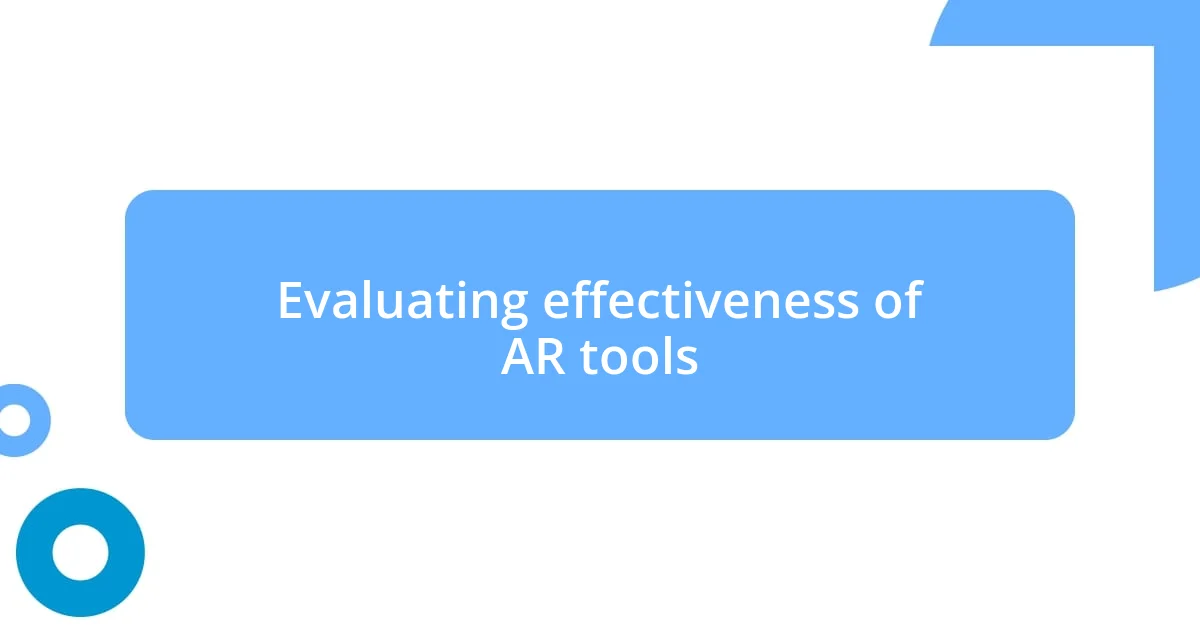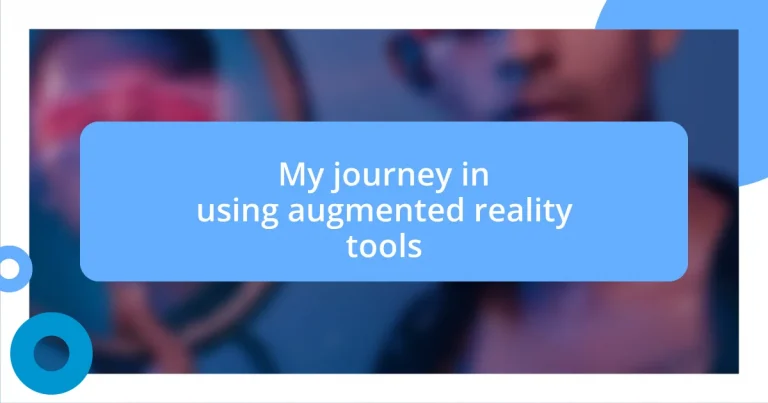Key takeaways:
- Augmented reality (AR) tools enhance user experiences by overlaying digital information onto real-world environments, significantly enriching learning and creativity.
- Selecting appropriate AR tools is crucial; factors such as purpose, compatibility, and usability should guide the choice to ensure effective use across varying tech-savviness levels.
- Evaluating AR’s effectiveness involves assessing student engagement and learning outcomes, with personalized feedback and integration of AR into traditional methods proving vital for maximizing impact.

Understanding augmented reality tools
Augmented reality (AR) tools overlay digital information onto the real world, creating an interactive experience that feels almost magical. I remember the first time I used an AR app; it was like stepping into a sci-fi movie where virtual elements seamlessly blended with my surroundings. Have you ever found yourself looking at a simple object and wondering what stories it could tell if it had a digital layer?
These tools can range from smartphone applications to complex headsets, each offering unique ways to explore and engage with our environment. I distinctly recall a moment when I used an AR application to visualize how a piece of furniture would look in my living room. It was eye-opening—suddenly, a mundane shopping decision became a thrilling adventure in design! Isn’t it fascinating how technology can transform the way we interact with everyday life?
In essence, understanding AR tools means recognizing their potential to enhance our perceptions and experiences. I’ve noticed that people often underestimate AR’s ability to enrich education and training. Just imagine learning anatomy by seeing 3D models of human organs right in front of you—how much more engaging would that be than reading a textbook?

My initial experiences with AR
I vividly remember my first encounter with an augmented reality app—it was during a day out at the museum. As I pointed my smartphone at a dinosaur skeleton, an animated T-Rex roared to life on my screen. It was such a surreal experience! I felt a rush of excitement, making me wonder how AR could change the way we approach learning and interacting with history.
Not long after that, I experimented with an AR tool for interior design. As I moved furniture around in my living room through the app, I realized how powerful it can be to visualize changes in one’s space. I felt a sense of empowerment, turning the daunting task of redecorating into a fun, creative process. Have you ever wished you could just move things around in real life like that?
Reflecting on those early experiences, I can’t help but feel that AR holds enormous potential. The sheer delight I felt during those moments has fueled my ongoing journey into this fascinating technology. It’s remarkable to think that something so simple as a smartphone could bring a new layer of understanding to both learning and creativity through augmented reality.
| Experience | Emotional Impact |
|---|---|
| Visiting a museum with AR | Excitement and wonder with interactive learning |
| Using AR for interior design | Empowerment and creativity while visualizing changes |

Selecting the right AR tools
Choosing the right AR tools can be a daunting task, especially given the plethora of options available today. I’ve often found myself sifting through various applications, trying to match them to my specific needs and preferences. One time, I selected an AR tool for a community project, and it turned out to be incredibly user-friendly, allowing both tech-savvy and less experienced users to create engaging content. That experience taught me that usability should be a top priority.
When selecting AR tools, consider these key factors:
- Purpose: Define what you want to achieve. Is it for education, design, or entertainment?
- Compatibility: Ensure the tool works seamlessly with your devices.
- Community and Support: Look for tools with active forums or customer support to help troubleshoot issues.
- Features: Evaluate their functionalities, such as 3D modeling, data visualization, or real-time interaction.
- Reviews and Recommendations: Seek out user feedback to gauge effectiveness and reliability.
I remember another occasion when I was trying to integrate AR for outdoor events, and the tool I chose not only worked beautifully in the daylight but also enhanced attendee engagement dramatically. This highlighted for me how environmental adaptability can be crucial in the decision-making process.

Enhancing learning through AR
Some of the most transformative moments in my learning journey came through the use of augmented reality in educational settings. I remember facilitating a workshop where we used AR to explore the solar system. The moment students pointed their devices at a plain classroom wall and watched planets orbiting around them was incredible. Seeing their faces light up with curiosity made me realize how AR can make complex subjects more accessible and engaging.
In another instance, I used an AR application designed for anatomy class. As I interacted with a 3D model of a human heart, I felt like I was stepping right into the realm of biology. That hands-on experience allowed me to grasp concepts that were previously just words in a textbook. Have you ever felt that spark when theory suddenly becomes tangible? It’s experiences like these that reinforce the idea that AR can significantly enhance learning by bridging the gap between abstract knowledge and real-world application.
Furthermore, AR encourages collaborative learning. During a project, my classmates and I utilized an AR tool to create a group presentation on environmental issues. The excitement of watching our presentations come to life as we scanned physical maps was unforgettable. I found that when learners collaborate in augmented environments, they not only share knowledge but also inspire each other to explore ideas more deeply. How great is it to learn with others while exploring interactive tools that foster creativity and teamwork?

Overcoming challenges in AR usage
One of the biggest challenges I faced while using augmented reality tools was navigating the technical glitches that sometimes arise. I vividly remember a project where the AR application froze midway through a live demonstration. My heart raced, thinking about how I would explain the sudden silence to my audience. Fortunately, I had prepared backup materials, which allowed me to pivot smoothly and keep the audience engaged while the app reloaded. This experience taught me the importance of always having a plan B and being adaptable when technology doesn’t cooperate.
Additionally, I often struggled with ensuring that the AR tools were accessible to all participants, especially when working with groups that had varying levels of tech-savviness. During one workshop, I noticed how some participants felt overwhelmed while others thrived in the AR environment. It struck me that providing a brief training session before diving in can bridge that gap, allowing everyone to benefit from the technology. Have you ever seen how a little extra support can change the dynamics of a group activity? It fosters a more inclusive atmosphere where everyone can participate actively and confidently.
Lastly, I’ve encountered instances where the initial excitement of using AR tools waned as the novelty wore off. In a few cases, I noticed that the initial buzz would diminish if the content wasn’t frequently refreshed. To counter this, I learned to continuously seek out new, relevant content that would keep participants engaged. For example, when we updated our AR experience with seasonal themes, the interaction levels surged. Isn’t it fascinating how keeping things fresh can rekindle enthusiasm? That’s a lesson I’ve carried through every subsequent use of AR tools, and it makes each session feel new and exciting.

Evaluating effectiveness of AR tools
Evaluating the effectiveness of augmented reality (AR) tools involves looking beyond just the technology itself; it’s about assessing the outcomes these tools generate. For instance, during a recent class, I asked students to rate their understanding of topics before and after using an AR application. The results shocked me: not only did their scores improve dramatically, but many shared anecdotes about how the AR experience ignited a deeper passion for the subject. Isn’t it fascinating to see how a simple tool can transform not just knowledge, but enthusiasm as well?
I also noticed that the effectiveness of AR tools can differ greatly depending on how they’re integrated into the curriculum. In one project, I took a hands-on approach by blending AR with traditional teaching methods, allowing students to experience content while also discussing it in real-time. The discussions became richer as they connected the dynamic visuals with their existing knowledge. Have you ever felt that connection where everything just clicks? That synergy highlighted the importance of thoughtful integration—AR is not a substitute for good teaching, but a powerful complement.
Moreover, regular feedback from participants proved invaluable in evaluating AR tools. During a workshop, I set up a quick feedback loop—students could text me their thoughts during the session. The instant feedback allowed me to adjust our activities on the fly based on what resonated with them. This adaptability led to a more tailored learning experience, and the excitement in their texts reminded me just how engaged they felt. Isn’t it remarkable how everyone’s perspective can shape the effectiveness of a learning tool?













